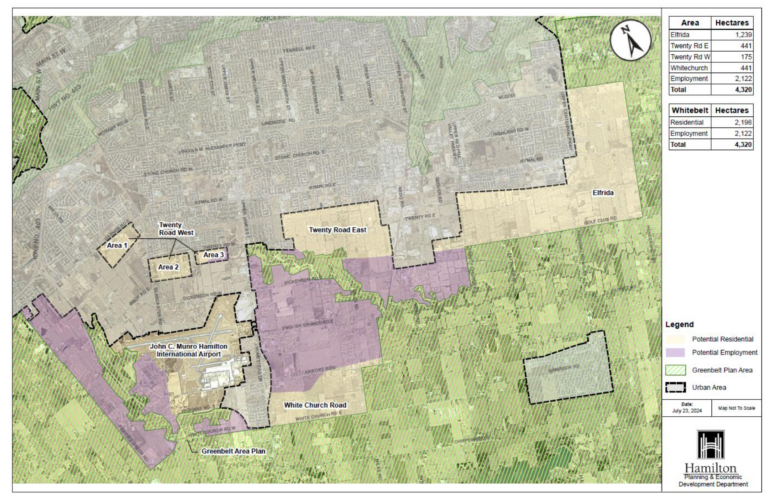The City of Hamilton is setting a high bar for any developer who wishes to gain municipal endorsement for privately initiated urban boundary expansions. In an extensive report to City Council, planning staff propose a comprehensive application process and criteria for boundary expansions.
The plan’s primary goal is to enable the City to argue that urban boundary expansions are unnecessary for the City of Hamilton to meet its provincial growth plan targets and that expansions will harm the municipality’s viability.
Hamilton will require developers to submit numerous studies, reports, and technical submissions, including a subwatershed study with a value estimate for ecological features the city will lose, an energy and climate change assessment, a financial impact analysis, a school accommodations plan, and a detailed concept plan.
The financial impact analysis must include “a per hectare servicing revenue/cost estimate for the proposed expansion area.”
Developers have filed expansion applications for all of Hamilton’s whitebelt land – that is, lands outside the urban boundary that are not within the Greenbelt.

The Upper West Side Landowners Group already at the Ontario Land Tribunal on appeal. (A eight-week hearing is scheduled beginning on April 13, 2026.)
A special Council meeting will be held on June 25, 2025, to vote on the Elfrida Lands and the White Church lands urban boundary applications
A separate application at 159 and 163 Sulphur Springs Road in Ancaster is for lands within the Greenbelt and the Niagara Escarpment Plan. It is being dealt with separately.
The City expects any application denials to be appealed to the Ontario Land Tribunal.
Correspondence to Council
The handful of letters from the public are split on the issue of urban boundary expansion.
2113522 Ontario Inc. (related to Vantage Group) writes they will apply to expand the urban boundary south and east of the airport for employment purposes.
The developers’ association, the West End Home Builders’ Association, is concerned about the proposed processes and the inclusion of rules beyond provincial requirements. They state that this will increase the cost of housing.
CEO Mike Collins-Williams writes:
“The City of Hamilton is increasingly debating and passing policies that are both anti-housing and anti-intensification, which, despite political commentary to the contrary, further supports planning and demographic justification for UBE. The City’s stated preference for a no-UBE scenario stands in stark contrast to the City’s own public and political policy, including the phase-out of Downtown CIPA incentives, a 30-storey height limit city-wide, the anti-intensification apartment tax (Community Benefits Charges), the rejection of many intensification projects and subsequent OLT cases, and the need to use Strong Mayor powers to move forward affordable housing projects.”
Council’s planning committee meets Tuesday beginning at 9:30 a.m.; the meeting will be livestreamed on YouTube.
Production Details
v. 1.0.0
Published: April 7, 2025
Last updated: April 7, 2025
Author: Joey Coleman
Update Record
v. 1.0.0 original version
